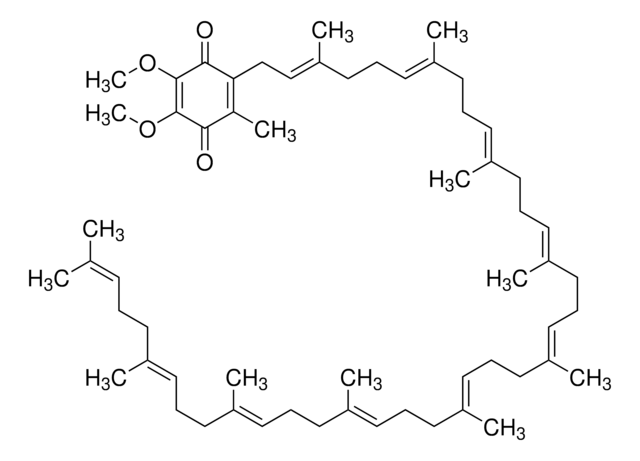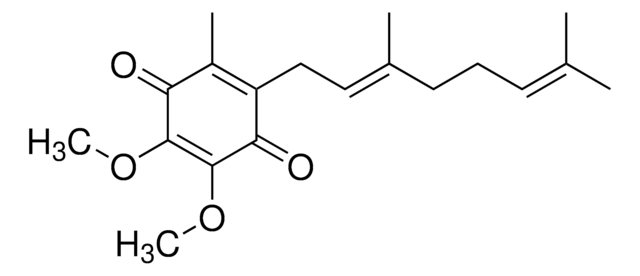C7956
Coenzym Q1
≥95%
Synonym(e):
2,3-Dimethoxy-5-methyl-6-(3-methyl-2-butenyl)-1,4-benzochinon, Ubichinon-1, Ubichinon-5
About This Item
Empfohlene Produkte
Qualitätsniveau
Assay
≥95%
Form
liquid
Lagertemp.
−20°C
SMILES String
COC1=C(OC)C(=O)C(C\C=C(\C)C)=C(C)C1=O
InChI
1S/C14H18O4/c1-8(2)6-7-10-9(3)11(15)13(17-4)14(18-5)12(10)16/h6H,7H2,1-5H3
InChIKey
SOECUQMRSRVZQQ-UHFFFAOYSA-N
Allgemeine Beschreibung
Anwendung
Biochem./physiol. Wirkung
Sonstige Hinweise
Lagerklassenschlüssel
10 - Combustible liquids
WGK
WGK 3
Flammpunkt (°F)
Not applicable
Flammpunkt (°C)
Not applicable
Persönliche Schutzausrüstung
Eyeshields, Gloves, multi-purpose combination respirator cartridge (US)
Analysenzertifikate (COA)
Suchen Sie nach Analysenzertifikate (COA), indem Sie die Lot-/Chargennummer des Produkts eingeben. Lot- und Chargennummern sind auf dem Produktetikett hinter den Wörtern ‘Lot’ oder ‘Batch’ (Lot oder Charge) zu finden.
Besitzen Sie dieses Produkt bereits?
In der Dokumentenbibliothek finden Sie die Dokumentation zu den Produkten, die Sie kürzlich erworben haben.
Kunden haben sich ebenfalls angesehen
Artikel
Learn about the four membrane-bound protein complexes that make up the electron transport chain metabolic pathway supplying energy as ATP for cellular respiration.
Unser Team von Wissenschaftlern verfügt über Erfahrung in allen Forschungsbereichen einschließlich Life Science, Materialwissenschaften, chemischer Synthese, Chromatographie, Analytik und vielen mehr..
Setzen Sie sich mit dem technischen Dienst in Verbindung.











